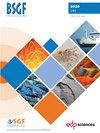A turning-point in the evolution of the Variscan orogen: the ca. 325 Ma regional partial-melting event of the coastal South Armorican domain (South Brittany and Vendée, France)
IF 2.6
3区 地球科学
Q2 GEOSCIENCES, MULTIDISCIPLINARY
引用次数: 24
Abstract
By drastically reducing the bulk strength of crustal materials, partial-melting is one of the main parameter controlling the rheological behaviour of the continental crust. With more than ca. 50% of the outcropping surface characterised by migmatites and granites, the coastal South Armorican domain, offers an opportunity to study deep-orogenic processes and more particularly, to understand the role of partial-melting for the late-evolution of the Variscan belt. To date, time-constraints are scarce hindering the understanding of this crucial stage in the Variscan belt evolution. This paper provides 29 new U-Th/Pb chemical ages on monazite collected over five sampling areas consisting in migmatite domes and late regional classic plutons. Based on structural, textural and chemical criteria, three main U-Th/Pb age-groups are distinguished. The first group, settled at ca. 335–330 Ma concerns samples of restites and core-domains of the monazite crystals for most of the granite massifs. Its significance is ascribed to inherited crystallisation ages probably recording the crossing of prograde monazite forming reactions (i.e. metamorphic isograds) during increasing P-T conditions in an overall nappe-stacking context. The second group that clusters at ca. 325–320 Ma corresponds to newly formed monazite grains that crystallised from juvenile silicate melts. Ages of this group are interpreted as crystallisation ages of leucosomes after a major partial-melting event that affected the whole domain. The last ca. 320 Ma group corresponds to rim-domains of monazite crystals. It is interpreted as the emplacement age of most of the large-scale granite massifs and therefore fixes the end of the partial-melting event. The inception and drastic generalisation of partial-melting at peak-P conditions therefore coincides with a major change in the tectonic regime recorded at regional-scale. In the lights of these results, this implies that (1) either continuous stacking of continental crustal units, rich in radiogenic elements, led to an increase of temperature within the orogenic wedge provoking partial-melting, the resulting drop in the crustal strength inducing collapse and lateral expansion of the belt, or (2) a drastic change of the boundary conditions has induced hot asthenospheric upwelling which in turn led to coeval extension and partial-melting. At a more local scale, strain benefited of the low-strength of the magmatic bodies prior to complete crystallisation promoting intense strain localisation within the South Armorican domain large-scale laccoliths often referred to as synkinematic plutons.Variscan造山带演化的一个转折点:约325 Ma的南美洲沿海地区(法国南布列塔尼和vendsamae)区域性部分融化事件
由于地壳物质的体积强度大大降低,部分熔融是控制大陆地壳流变行为的主要参数之一。南美洲沿海地区超过50%的露头表面以混染岩和花岗岩为特征,为研究深部造山过程提供了机会,更具体地说,是了解部分熔融在瓦里斯坎带晚期演化中的作用。到目前为止,时间限制很少妨碍理解瓦里斯坎带演化的这一关键阶段。本文提供了5个采样区单独居石的29个新的U-Th/Pb化学年龄,这些采样区包括混辉岩穹丘和晚期区域性经典岩体。根据结构、结构和化学指标,划分出3个主要的U-Th/Pb年龄群。第一组沉积在约335-330 Ma,涉及大多数花岗岩块体的辉石和独居石晶体的核域样本。它的意义在于继承结晶年龄,可能记录了在整体推覆层的P-T增加的条件下,渐进式单氮石形成反应(即变质等梯度)的交叉。第二组聚集在约325-320 Ma,对应于新形成的独居石颗粒,这些颗粒是由幼年硅酸盐熔体结晶而成。这一组的年龄被解释为白色小体在影响整个区域的主要部分熔融事件后的结晶年龄。最后一个约320 Ma的群对应于独居石晶体的环畴。它被解释为大多数大型花岗岩块体的就位年龄,因此确定了部分熔融事件的结束。因此,p峰条件下部分熔融的开始和剧烈的推广与区域尺度上记录的构造制度的重大变化是一致的。根据这些结果,这表明:(1)富含放射性成因元素的大陆地壳单元的连续堆积导致造山带内温度升高,引起部分熔融,从而导致地壳强度下降,引起构造带的崩塌和横向扩张;(2)边界条件的剧烈变化引起热软流圈上升流,从而导致同期伸展和部分熔融。在更局部的尺度上,应变受益于岩浆体在完全结晶之前的低强度,促进了南美洲域内大型漆膜岩(通常被称为同动岩体)的强烈应变局域化。
本文章由计算机程序翻译,如有差异,请以英文原文为准。
求助全文
约1分钟内获得全文
求助全文
来源期刊
CiteScore
5.80
自引率
0.00%
发文量
18
审稿时长
>12 weeks
期刊介绍:
BSGF - Earth Sciences Bulletin publie plusieurs types de contributions :
1. des articles originaux, couvrant tous les champs disciplinaires des Géosciences, à vocation fondamentale mais également à vocation plus appliquée (risques, ressources);
2. des articles de synthèse, faisant le point sur les avancées dans un domaine spécifique des Géosciences, qu''elles soient méthodologiques ou régionales ;
3. des monographies sur la géologie d’une région donnée, assorties d’informations supplémentaires, cartes, coupes, logs, profils sismiques … publiées en ligne en annexe de l’article ;
4. des articles courts de type « express letter » ;
5. des livrets-guides d’excursion (qui suivront le même processus d’examen éditorial que les articles plus classiques) ;
6. des comptes rendus de campagnes à la mer ;
7. des articles de données géodésiques, géophysiques ou géochimiques, pouvant devenir des articles de référence pouvant conduire à des interprétations ultérieures.
BSGF - Earth Sciences Bulletin constitue également un forum pour les discussions entre spécialistes des Sciences de la Terre, de type comment-reply ou autre. Tous les articles publiés, quelle que soit leur forme, seront accessibles sans frais (articles en Open Access) sur le site de la SGF et sur celui de Geosciences World dans la mesure où les auteurs se seront acquittés d’une contribution de (Article Processing Charges – APC) de 300€ pour les membres de la SGF et 500€ pour les non-membres.

 求助内容:
求助内容: 应助结果提醒方式:
应助结果提醒方式:


